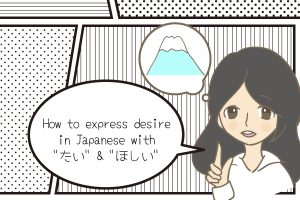How to conjugate verbs in Japanese Part Ⅲ
Last time, we took a look at exceptions from the verb conjugation rules we learned in the previous lesson. In this lesson, Shiho will introduce the conjugation of the “te”-form, or “テ形”. The te-form is used for various grammar points in Japanese and it’s therefore crucial to remember how to conjugate it!
| Table of Contents [テ形 – the te-form] [Conjugating the te-form for verbs of group ②] [Conjugating the te-form for verbs of group ③] [Conjugating the te-form for verbs of group ①] [Practice] |
[テ形 – the te-form]
Today we will take a look at the te-form or “テ形”, one of the most important verb conjugations in Japanese grammar. We will first take a look at how to conjugate it for verbs of group ② (ru-verbs), then group ③ (irregular verbs) and lastly group ① (u-verbs).
[Conjugating the te-form for verbs of group ②]
Ru-verbs are by far the easiest to conjugate into the te-form! You simply change the “る” at the end of the “辞書形” or dictionary form to “て”.
る → て
Examples:
食べる → 食べて
見る → 見て
[Conjugating the te-form for verbs of group ③]
Next, let’s take a look at how to conjugate irregular verbs. Do you still remember which verbs are part of group ③? It’s “来る” and “する”! There is no rule for the irregular verbs, so you will have to learn by heart how the te-form is conjugated:
来る → 来て
する → して
Actually, there are lots of verbs in Japanese that are built out of “noun + する”. All of these verb constructs ending on “する” are conjugated in the exact same way as a “single” “する”. For example:
勉強する → 勉強して
準備する → 準備して
電話する → 電話して
[adsense]
[Conjugating the te-form for verbs of group ①]
Lastly we will learn how to conjugate verbs of group ①, the u-verbs into the te-form. U-verbs are a bit more difficult, because we will need to break them up into four sub-groups to be able to conjugate them correctly. We will divide them based on the last syllable of their “辞書形” or dictionary form.
① く・ぐ
② む・ぶ・ぬ
③ る・つ・う
④ す
① く・ぐ
く・ぐ → いて・いで
To conjugate the first two you conjugate the last syllable of the dictionary form by changing it to “ite” or “ide”. If the verb ends on “ku” you use “ite”. If the verb ends on “gu” you exchange it for “ide”. Look at the examples below:
書く → 書いて
ぬぐ → ぬいで
However, there is one exception to this group, and that is the verb “行く” (to go). The te-form of “行く” is “行って”. Since “行く” is a very common verb in Japanese, make a point of practicing this exception!
② む・ぶ・ぬ
む・ぶ・ぬ → んで
The next group includes all verbs ending on “mu”, “bu”, or “nu”. All verbs ending on these syllables are conjugated to the te-form by changing the last syllable to “nde”. Look at the following examples:
読む → 読んで
遊ぶ → 遊んで
死ぬ → 死んで
③ る・つ・う
る・つ・う → って
Verbs of group ① ending on “ru”, “tsu”, or “u” have their last syllable changed to “tte”. Here is a list with examples of commonly used verbs:
取る → 取って
持つ → 持って
会う → 会って
④ す
す → して
Verbs ending on “su” are conjugated to the te-form by changing “su” to “shite”. Examples:
押す → 押して
話す → 話して
Because of all the sub-groups, the group of u-verbs is obviously the easiest one to get wrong. Especially group 1 and group 3 (“ite”, “ide” vs. “tte”) are easy to mix up, and many learners try to use “ite” for verbs of group 3 instead of “tte”.
[Practice]
The best way to learn, however, is by looking for some examples of each group and start practicing! So let’s start right now. Can you conjugate the following verbs into their respective te-forms?
(Find the solutions with explanations at the bottom).
Q.1 言う
Q.2 寝る
Q.3 頼む
Q.4 騒ぐ
Q.5 持つ
Q.6 来る
Q.7 磨く
Q.8 呼ぶ
Q.9 起きる
Q.10 急ぐ
Q.11 練習する
Q.12 立つ
Q.13 返す
Q.14 運ぶ
Q.15 行く
Q.1 言う is an u-verb of sub-group 3, so the solution is:
→言って
Q.2 寝る belongs to the ru-verbs, so the solution is:
→寝て
Q.3 頼む is an u-verb of sub-group 2, so the solution is:
→頼んで
Q.4 騒ぐ belongs to the u-verbs and is a part of sub-group 1, so the te-form is:
→騒いで
Q.5 持つ is an u-verb of sub-group 3, so the te-form is:
→持って
Q.6 来る is an irregular verb. The te-form is:
→来て
Q.7 磨く is an u-verb of sub-group 3, so the right answer is:
→磨いて
Q.8 呼ぶ is also an u-verb, but belongs to sub-group 2. The te-form is:
→呼んで
Q.9 起きる is not an exception and thus a ru-verb. Its te-form is:
起きて
Q.10 急ぐ is an u-verb of sub-group 1. The solution is:
→急いで
Q.11 練習する is an irregular verb. The te-form of する is:
→練習して
Q.12 立つ is an u-verb of sub-group 3. The te-form is:
→立って
Q.13 返す is also an u-verb, but of sub-group 4. The solution is:
→返して
Q.14 運ぶ belongs to the group of u-verbs, sub-group 2. The te-form is:
→運んで
Q.15 行く is an exception, although it belongs to the u-verbs. Do you remember what the correct te-form is?
→行って
Don’t give up in practicing these verbs. Why not write down some verbs out of Mangas you read or Animes you watch and try practicing the te-form conjugation? The best way to remember them is to recognise, practice and use!
Don’t forget to check out the video on this class and tune in to our livestream every wednesday at 6pm (JST) for the real deal!
| 勉強する | To study |
| 準備する | To prepare |
| 電話する | To call (on the phone) |
| 頼む | To order |
| 騒ぐ | To make noise, to make a ruckus |
| 磨く | To brush (e.g. teeth), to polish |
| 急ぐ | To hurry |
| 練習する | To practice |
| 立つ | To stand |
| 返す | To return, to put back |
| 運ぶ | To move, to carry |

How to conjugate verbs in Japanese Part Ⅱ

How to express desire in Japanese using “たい” & “ほしい”



